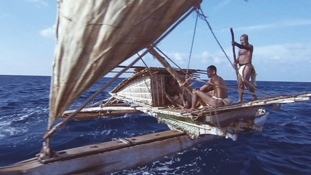The first scene of episode two of South Pacific, “Castaways,” introduces in plain view the stealth-work of the series. Benedict Cumberbatch, the clipped narrator, says, “So who were those castaways, and how did they ever reach these far-flung islands?” Insular gigantism, island dwarfism, mutational ninjistics—this episode will be a showcase for the animals, we think. Yet, as Cumberbatch speaks, the camera withdraws at an excruciating creep into the sky above some island: a huddle of trees, a shallow sea, and, finally, an endless blue, with the shadow of some high clouds edging in. It’s a very patient broadening of the camera’s perspective—and, in kind, the episode will purport to chat about creaturely matters while a serious meditation on geography sneaks through.
For the best cinematic resources put to documentary service, people know to spend their hours with the BBC Science and Nature unit. Life, The Blue Planet, Human Planet, Frozen Planet, Planet Earth—each of these series delivers the relaxing, frothy soma of a skilled technical team forming a plan and sticking to it. Beyond these, though, the unit’s output feels off-brand and diminutive: Wild China? Andes to Amazon? Forget it. South Pacific seems to have escaped popular notice perhaps because its focus is so tight. There is a hint in the title, which drably describes a region, that the six-part series will offer fewer zoological thrills; even the subtitle—“One Ocean. 20,000 Islands. One Quarter of the World’s Water”—limits itself to the facts.
But the facts, in this case, turn out to be perfectly descriptive: South Pacific is a document not of nature but of space. And while it’s not a quiet study—it is a turbulent program, in fact—the conflicts are wrought through distances, the disjuncture of forms, the throwing up of existents against the fields in which they exist.
For instance, while we instinctually think of water as traversable, one archvillain turns out to be the high seas, a serious barrier to underwater travel. So we are introduced to the groupers, who overcome this obstacle via their progeny—their larvae can travel through open water to populate new reefs—and when their spawning is interrupted by a squadron of gray reef sharks, it’s a spatial dread that pervades the whole ordeal. Non-copulating groupers, Cumberbatch explains, are too quick for such predation; the only...
You have reached your article limit
Sign up for a digital subscription and continue reading all new issues, plus our entire archives, for just $1.50/month.
Already a subscriber? Sign in





